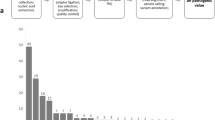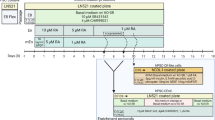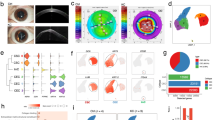Abstract
Keratoconus (KTCN), a non-inflammatory corneal disorder characterized by stromal thinning, represents a major cause of corneal transplantations. Genetic and environmental factors have a role in the etiology of this complex disease. Previously reported linkage analysis revealed that chromosomal region 13q32 is likely to contain causative gene(s) for familial KTCN. Consequently, we have chosen eight positional candidate genes in this region: MBNL1, IPO5, FARP1, RNF113B, STK24, DOCK9, ZIC5 and ZIC2, and sequenced all of them in 51 individuals from Ecuadorian KTCN families and 105 matching controls. The mutation screening identified one mutation and three sequence variants showing 100% segregation under a dominant model with KTCN phenotype in one large Ecuadorian family. These substitutions were found in three different genes: c.2262A>C (p.Gln754His) and c.720+43A>G in DOCK9; c.2377-132A>C in IPO5 and c.1053+29G>C in STK24. PolyPhen analyses predicted that c.2262A>C (Gln754His) is possibly damaging for the protein function and structure. Our results suggest that c.2262A>C (p.Gln754His) mutation in DOCK9 may contribute to the KTCN phenotype in the large KTCN-014 family.
Similar content being viewed by others
Log in or create a free account to read this content
Gain free access to this article, as well as selected content from this journal and more on nature.com
or
References
Rabinowitz YS : Keratoconus. Surv Ophthalmol 1998; 42: 297–319.
Fink BA, Sinnott LT, Wagner H, Friedman C, Zadnik K : The influence of gender and hormone status on the severity and progression of keratoconus. Cornea 2010; 29: 65–72.
Ertan A, Muftuoglu O : Keratoconus clinical findings according to different age and gender groups. Cornea 2008; 27: 1109–1113.
Georgiou T, Funnell CL, Cassels-Brown A, O’Conor R : Influence of ethnic origin on the incidence of keratoconus and associated atopic disease in Asians and white patients. Eye (Lond) 2004; 18: 379–383.
Rabinowitz YS : The genetics of keratoconus. Ophthalmol Clin North Am 2003; 16: 607–620.
Robertson I : Keratoconus and the Ehlers-Danlos syndrome: a new aspect of keratoconus. Med J Aust 1975; 1: 571–573.
Sharif KW, Casey TA, Coltart J : Prevalence of mitral valve prolapse in keratoconus patients. J R Soc Med 1992; 85: 446–448.
Beckh U, Schönherr U, Naumann GO : Autosomal dominant keratoconus as the chief ocular symptom in Lobstein osteogenesis imperfecta tarda. Klin Monbl Augenheilkd 1995; 206: 268–272.
Cullen JF, Butler HG : Mongolism (Down's syndrome) and keratoconus. Br J Ophthalmol 1963; 47: 321–330.
Elder MJ : Leber congenital amaurosis and its association with keratoconus and keratoglobus. J Pediatr Ophthalmol Strabismus 1994; 31: 38–40.
Nowak DM, Gajecka M : The genetics of keratoconus. Middle East Afr J Ophthalmol 2011; 18: 2–6.
McMonnies CW, Boneham GC : Keratoconus, allergy, itch, eye-rubbing and hand-dominance. Clin Exp Optom 2003; 86: 376–384.
Bawazeer AM, Hodge WG, Lorimer B : Atopy and keratoconus: a multivariate analysis. Br J Ophthalmol 2000; 84: 834–836.
Bechara SJ, Waring III GO, Insler MS : Keratoconus in two pairs of identical twins. Cornea 1996; 15: 90–93.
Edwards M, McGhee CN, Dean S : The genetics of keratoconus. Clin Experiment Ophthalmol 2001; 29: 345–351.
Tyynismaa H, Sistonen P, Tuupanen S et al: A locus for autosomal dominant keratoconus: linkage to 16q22.3-q23.1 in Finnish families. Invest Ophthalmol Vis Sci 2002; 43: 3160–3164.
Brancati F, Valente EM, Sarkozy A et al: A locus for autosomal dominant keratoconus maps to human chromosome 3p14-q13. J Med Genet 2004; 41: 188–192.
Hutchings H, Ginisty H, Le Gallo M et al: Identification of a new locus for isolated familial keratoconus at 2p24. J Med Genet 2005; 42: 88–94.
Burdon KP, Coster DJ, Charlesworth JC et al: Apparent autosomal dominant keratoconus in a large Australian pedigree accounted for by digenic inheritance of two novel loci. Hum Genet 2008; 124: 379–386.
Tang YG, Rabinowitz YS, Taylor KD et al: Genomewide linkage scan in a multigeneration Caucasian pedigree identifies a novel locus for keratoconus on chromosome 5q14.3-q21.1. Genet Med 2005; 7: 397–405.
Bisceglia L, De Bonis P, Pizzicoli C et al: Linkage analysis in keratoconus: replication of locus 5q21.2 and identification of other suggestive loci. Invest Ophthalmol Vis Sci 2009; 50: 1081–1086.
Li X, Rabinowitz YS, Tang YG et al: Two-stage genome-wide linkage scan in keratoconus sib pair families. Invest Ophthalmol Vis Sci 2006; 47: 3791–3795.
Liskova P, Hysi PG, Waseem N, Ebenezer ND, Bhattacharya SS, Tuft SJ : Evidence for keratoconus susceptibility locus on chromosome 14: a genome-wide linkage screen using single-nucleotide polymorphism markers. Arch Ophthalmol 2010; 128: 1191–1195.
Hughes AE, Dash DP, Jackson AJ, Frazer DG, Silvestri G : Familial keratoconus with cataract: linkage to the long arm of chromosome 15 and exclusion of candidate genes. Invest Ophthalmol Vis Sci 2003; 44: 5063–5066.
Hameed A, Khaliq S, Ismail M et al: A novel locus for Leber congenital amaurosis (LCA4) with anterior keratoconus mapping to chromosome 17p13. Invest Ophthalmol Vis Sci 2000; 41: 629–633.
Fullerton J, Paprocki P, Foote S, Mackey DA, Williamson R, Forrest S : Identity-by-descent approach to gene localisation in eight individuals affected by keratoconus from north-west Tasmania, Australia. Hum Genet 2002; 110: 462–470.
Udar N, Atilano SR, Brown DJ et al: SOD1: a candidate gene for keratoconus. Invest Ophthalmol Vis Sci 2006; 47: 3345–3351.
Héon E, Greenberg A, Kopp KK et al: VSX1: a gene for posterior polymorphous dystrophy and keratoconus. Hum Mol Genet 2002; 11: 1029–1036.
Gajecka M, Radhakrishna U, Winters D et al: Localization of a gene for keratoconus to a 5.6-Mb interval on 13q32. Invest Ophthalmol Vis Sci 2009; 50: 1531–1539.
Whitelock RB, Li Y, Zhou LL, Sugar J, Yue BY : Expression of transcription factors in keratoconus, a cornea-thinning disease. Biochem Biophys Res Commun 1997; 235: 253–258.
Nakamura H, Chiambaretta F, Sugar J, Sapin V, Yue BYJT : Developmentally regulated expression of KLF6 in the mouse cornea and lens. Invest Ophthalmol Vis Sci 2004; 45: 4327–4332.
Cristina Kenney M, Brown DJ : The cascade hypothesis of keratoconus. Cont Lens Anterior Eye 2003; 26: 139–146.
Kanadia RN, Urbinati CR, Crusselle VJ et al: Developmental expression of mouse muscleblind genes Mbnl1, Mbnl2 and Mbnl3. Gene Expr Patterns 2003; 3: 459–462.
Koyano Y, Kawamoto T, Shen M et al: Molecular cloning and characterization of CDEP, a novel human protein containing the ezrin-like domain of the band 4.1 superfamily and the Dbl homology domain of Rho guanine nucleotide exchange factors. Biochem Biophys Res Commun 1997; 241: 369–375.
Kwofie MA, Skowronski J : Specific recognition of Rac2 and Cdc42 by DOCK2 and DOCK9 guanine nucleotide exchange factors. J Biol Chem 2008; 283: 3088–3096.
Schinkmann K, Blenis J : Cloning and characterization of a human STE20-like protein kinase with unusual cofactor requirements. J Biol Chem 1997; 272: 28695–28703.
Yaseen NR, Blobel G : Cloning and characterization of human karyopherin beta3. Proc Natl Acad Sci USA 1997; 94: 4451–4456.
Krawczyk E, Hanover JA, Schlegel R, Suprynowicz FA : Karyopherin beta3: a new cellular target for the HPV-16 E5 oncoprotein. Biochem Biophys Res Commun 2008; 371: 684–688.
Rozen S, Skaletsky H : Primer3 on the WWW for general users and for biologist programmers. Methods Mol Biol 2000; 132: 365–386.
Ng PC, Henikoff S : SIFT: predicting amino acid changes that affect protein function. Nucleic Acids Res 2003; 31: 3812–3814.
Ramensky V, Bork P, Sunyaev S : Human non-synonymous SNPs: server and survey. Nucleic Acids Res 2002; 30: 3894–3900.
Thompson JD, Higgins DG, Gibson TJ : CLUSTAL W: improving the sensitivity of progressive multiple sequence alignment through sequence weighting, position-specific gap penalties and weight matrix choice. Nucleic Acids Res 1994; 22: 4673–4680.
Chomczynski P : A reagent for the single-step simultaneous isolation of RNA, DNA and proteins from cell and tissue samples. Biotechniques 1993; 15: 532–534, 536–537.
Wigginton JE, Abecasis GR : PEDSTATS: descriptive statistics, graphics and quality assessment for gene mapping data. Bioinformatics 2005; 21: 3445–3447.
Weeks DE, Sobel E, O’Connell JR, Lange K : Computer programs for multilocus haplotyping of general pedigrees. Am J Hum Genet 1995; 56: 1506–1507.
Sobel E, Lange K : Descent graphs in pedigree analysis: applications to haplotyping, location scores, and marker-sharing statistics. Am J Hum Genet 1996; 58: 1323–1337.
Matise TC, Chen F, Chen W et al: A second-generation combined linkage physical map of the human genome. Genome Res 2007; 17: 1783–1786.
Thiele H, Nürnberg P : HaploPainter: a tool for drawing pedigrees with complex haplotypes. Bioinformatics 2005; 21: 1730–1732.
Côté J, Vuori K : Identification of an evolutionarily conserved superfamily of DOCK180-related proteins with guanine nucleotide exchange activity. J Cell Sci 2002; 115: 4901–4913.
Côté J, Motoyama AB, Bush JA, Vuori K : A novel and evolutionarily conserved PtdIns(3,4,5)P3-binding domain is necessary for DOCK180 signalling. Nat Cell Biol 2005; 7: 797–807.
Hara S, Kiyokawa E, Iemura S et al: The DHR1 domain of DOCK180 binds to SNX5 and regulates cation-independent mannose 6-phosphate receptor transport. Mol Biol Cell 2008; 19: 3823–3835.
Lomelin D, Jorgenson E, Risch N : Human genetic variation recognizes functional elements in noncoding sequence. Genome Res 2010; 20: 311–319.
Baralle D, Baralle M : Splicing in action: assessing disease causing sequence changes. J Med Genet 2005; 42: 737–748.
Detera-Wadleigh SD, Liu C, Maheshwari M et al: Sequence variation in DOCK9 and heterogeneity in bipolar disorder. Psychiatr Genet 2007; 17: 274–286.
Wang Z, Liu Y, Wu N et al: Genetic and functional study of the IPO5 gene in schizophrenia. Psychiatry Res 2011; 187: 460–461.
Brzustowicz LM, Honer WG, Chow EW et al: Linkage of familial schizophrenia to chromosome 13q32. Am J Hum Genet 1999; 65: 1096–1103.
Rudisch B, D’Orio B, Compton MT : Keratoconus and psychosis. Am J Psychiatry 2003; 160: 1011.
Huang CF, Wu Y, Hsu C et al: Caspase activation of mammalian sterile 20-like kinase 3 (Mst3). Nuclear translocation and induction of apoptosis. J Biol Chem 2002; 277: 34367–34374.
Lee W, Hsu C, Wang P, Huang CF, Chang C, Yuan C : Identification and characterization of the nuclear import and export signals of the mammalian Ste20-like protein kinase 3. FEBS Lett 2004; 572: 41–45.
Wu H, Lin C, Lin T, Chen T, Yuan C : Mammalian Ste20-like protein kinase 3 mediates trophoblast apoptosis in spontaneous delivery. Apoptosis 2008; 13: 283–294.
Stegert MR, Hergovich A, Tamaskovic R, Bichsel SJ, Hemmings BA : Regulation of NDR protein kinase by hydrophobic motif phosphorylation mediated by the mammalian Ste20-like kinase MST3. Mol Cell Biol 2005; 25: 11019–11029.
Lorber B, Howe ML, Benowitz LI, Irwin N : Mst3b, an Ste20-like kinase, regulates axon regeneration in mature CNS and PNS pathways. Nat Neurosci 2009; 12: 1407–1414.
Ciomborowska J, Nowak W, Rogozin IB, ałowska I : Primate and rodent specific intron gains and the origin of retrogenes with splice variants. Mol Biol Evol 2011; 28: 33–37.
Stabuc-Silih M, Strazisar M, Hawlina M, Glavac D : Absence of pathogenic mutations in VSX1 and SOD1 genes in patients with keratoconus. Cornea 2010; 29: 172–176.
Aldave AJ, Yellore VS, Salem AK et al: No VSX1 gene mutations associated with keratoconus. Invest Ophthalmol Vis Sci 2006; 47: 2820–2822.
Acknowledgements
We thank Kristen A Bailey for assistance with sequencing data analyses, and Genomed Company (Warsaw, Poland) for support in sequencing service. This work was supported by the Polish Ministry of Science and Higher Education, Grant NN 402097837 and Grant NN 402591740.
Author information
Authors and Affiliations
Corresponding author
Ethics declarations
Competing interests
The authors declare no conflict of interest.
Additional information
Supplementary Information accompanies the paper on European Journal of Human Genetics website
Supplementary information
Rights and permissions
About this article
Cite this article
Czugala, M., Karolak, J., Nowak, D. et al. Novel mutation and three other sequence variants segregating with phenotype at keratoconus 13q32 susceptibility locus. Eur J Hum Genet 20, 389–397 (2012). https://doi.org/10.1038/ejhg.2011.203
Received:
Revised:
Accepted:
Published:
Issue date:
DOI: https://doi.org/10.1038/ejhg.2011.203
Keywords
This article is cited by
-
Investigation of Potential Crucial Genes and Key Pathways in Keratoconus: An Analysis of Gene Expression Omnibus Data
Biochemical Genetics (2023)
-
Omics Analyses in Keratoconus: from Transcriptomics to Proteomics
Current Ophthalmology Reports (2020)
-
The Proteins of Keratoconus: a Literature Review Exploring Their Contribution to the Pathophysiology of the Disease
Advances in Therapy (2019)
-
PPIP5K2 and PCSK1 are Candidate Genetic Contributors to Familial Keratoconus
Scientific Reports (2019)
-
Genetic Aspects of Keratoconus: A Literature Review Exploring Potential Genetic Contributions and Possible Genetic Relationships with Comorbidities
Ophthalmology and Therapy (2018)



